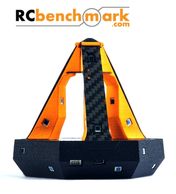Welcome to DroneTB
Welcome to DroneTB
Welcome to DroneTBWelcome to DroneTBWelcome to DroneTBAbout DroneTB
What is it?
DroneTB is a purpose-built unmanned flying test bed, which allows aerospace products to be developed, evaluated and tested under real-world dynamic flight conditions.
DroneTB is currently in development at the University of Southampton, UK.
What can it do?
DroneTB performs inertial tests which simply cannot be done on the ground. Manoeuvres such as prolonged turns, negative-g dives, or sequences of dynamic movements can be performed accurately and repeatedly. Rather than simulating or testing individual sub-components, the whole product can be tested in its 'as-delivered' configuration.
What are the benefits?
DroneTB gives aerospace manufacturers the ability to perform rapid development, while minimising the risk of problems during certification or customer acceptance. Test data can be gathered easily, instead of relying on manned test flights or feedback from aircraft integration teams. Before-and-after evaluations of a product modification can be verified, as well as performance comparisons against competitors' products.
Features
Attitude reference
- Active tracking using the Otus tracker from RCBenchmark
- Passive tracking using the Vicon camera system, and motion capture balls
- Cross-comparison with flight log data from DroneTB's own flight controller
Unit Under Test (UUT) integration
- Purpose-built airframe designed to best locate the UUT
- Vibration-damped UUT mounting
- Stimulus vibration inputs from Eccentric Mass Motors
Performance analysis
- Flight data logged on-board and on-ground
- Cross comparison with multiple data sources
- Cross comparison with previous flights
Specifications
Payload
Total 6 kg payload:
2 kg Unit Under Test
2 kg payload battery
2 kg payload support equipment
Endurance
Minimum 9 minutes at full payload.
(Uprgradeable with motor options and extra batteries.)
Maximum Takeoff Mass (MTOM)
15 kg including full payload.
(Upgradeable to 20 kg with motor options and extra batteries.)
Cruising speed
12 m/s (23 kts) at full payload
Airframe configuration
Coaxial quad multirotor (8 propellers)
Conventional quad (4 propellers) configuration option for smaller payloads, and operation under < 7 kg MTOM flight regimes
Dimensions
Airframe: 755 mm wide x 755 mm deep, x 500 mm high (GPS mast deployed)
Propeller tip to tip: 1212 x 1212 mm
Airframe is partially demountable for transport and storage
Flight tracking technologies used by DroneTB
Otus Tracker

The Otus Tracker from RCBenchmark uses active laser scanning developed for the Virtual Reality headset industry. It is capable of fast and accurate measurement of position and attitude.
Vicon motion capture camera system

The Vicon camera system is used in the movie industry for motion capture and object tracking. It uses reflective balls placed on the aircraft.
Pixhawk 2.1 with Cube sensor pack and HERE+ GPS

The Pixhawk 2.1 by ProFiCNC is DroneTB's flight controller. It is fitted with an upgraded Cube inertial sensor pack, and HERE+ GPS for optimum attitude and positioning.
FAQs

What products can be tested with DroneTB?
DroneTB is designed to test commercial aerospace products such as Attitude Indicator cockpit displays, and Attitude Heading and Reference Systems (AHRS) units. Other products such as Air Data Computers can also be evaluated. DroneTB can also be used to compare the performance of motors, propellers and flight controllers used in the drone industry.
How does DroneTB work?
DroneTB uses a combination of data gathered from optical and inertial measurements to compare against the performance of the Unit Under Test.
Indoor flight testing uses accurate instantaneous readings from optical tracking systems. The Otus tracker system from RCBenchmark is an adaptation of virtual reality headset tracking technology, which uses scanning lasers to determine the position and attitude of DroneTB. The Vicon tracker system uses reflective balls positioned on the aircraft to perform motion tracking similar to that used in the movie industry.
Outdoor flight testing uses data from the DroneTB's own Pixhawk 2 flight controller, to allow longer flight paths. In order to ensure accuracy, DroneTB will periodically fly through a 'gate' section containing the optical tracking systems.
Why not use an off-the-shelf drone?
Most off-the-shelf consumer drones are designed to carry photography equipment, typically underneath the drone. DroneTB was designed around the platform containing the Unit Under Test, to offer the best mounting position, and vibration damping.
Wouldn't the drone need to be as fast as a real aircraft?
No, not for the majority of manoeuvers listed in the AHRS Minimum Operational Performance Standards, which require turns, descents, and accelerations rather than top speed. The purpose of DroneTB is to shorten and de-risk the product development phase, but ultimately testing on the target aircraft will always be required.
Why not use a flight simulator?
A full-motion flight simulator is designed to convince a human, using the natural force of gravity and visual cues. It is not a true representation of the forces experienced in dynamic flight.
Why not use a racetrack, roller-coaster, centrifuge, boom arm, turntable, pendulum, etc...?
DroneTB is capable of all of these movements. Each of these tests would require a different piece of hardware, which would be limited to a fixed, narrow range of motion. DroneTB allows the flexibility and adaptability to cover the majority of possible ground-based tests, in addition to tests which would be impossible to perform on the ground.
Photo Gallery
Autonomous Vehicles Laboratory

Contact Us
DroneTB is an MSc research project led by Colin Whiteley, and supervised by Prof Keith Towell at the University of Southampton.
University of Southampton
Faculty of Engineering and the Environment , Boldrewood Innovation Campus Building 176, Southampton SO16 7QF United Kingdom
Enquiry form
Copyright © 2017 Colin Whiteley - All Rights Reserved.
Powered by GoDaddy Website Builder




